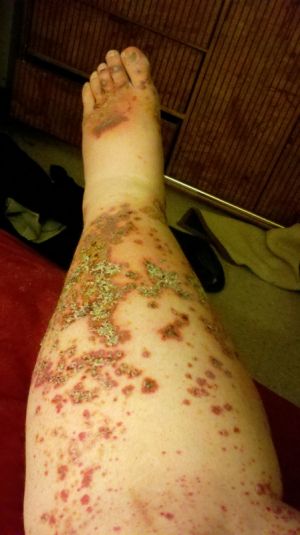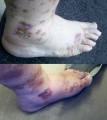Leukocytoclastic vasculitis
| This article is a stub. I'll get around to lengthening it when I feel like it :) |
TL;DR
For the TL;DR crowd: In February I developed a condition called leukocytoclastic vasculitis, which is essentially a disease where the immune system decides your blood vessels are foreign invaders and attempts to destroy them. It appears to be chronic, however, there doesn't appear to be internal organ involvement, and it looks like we're finally getting it under control with oral steroids.
2013-06-27: *Deep breath* Here goes...
|
When your dermatologist hands you a copy of the page from her reference book and you see the first line includes "small-vessel necrotizing vasculitis", the teenage boy in you reading his mom's medical encyclopedia starts shouting "Cool! I have something with necrotizing in the description!", but then the middle-aged man in you kicks in and says "YOU FOOL! DON'T YOU UNDERSTAND THAT MEANS DEATH! YOUR OWN IMMUNE SYSTEM IS OUT TO KILL YOU!" however, the teenager mumbles under his breath as he goes out the door, "I still think it's cool."
Today is my father's birthday and I wanted to call him to say hi, however, I know he's going to ask me if I'm coming to the annual family get-together, and I need to
Go to an ER now! secondary infection Sick Leave Rash on back and arms, abdomen stages (rash/itch, purpura/sensitivity, RLS from hell (acid needle), oozing/ice pick hypersensitivity hypersensitivity, screaming malaise, insomnia Scare with bloody underwear Ulcerations blood in all pieces of clothing.... *sigh*
bloody socks are a regular thing.
Biopsy results
On 2013-05-10 I went in to a surgeon to get a two-punch biopsy on a fresh lesion. The biopsy results indicated the following:
|
|
Translation: "Yeah, it's leukocytoclastic vasculitis, but we don't have a clue what's causing it." The rheumatologist gave the analogy of being set down from a balloon in the middle of a cornfield. You know you are in a cornfield, but you don't have a clue what country you are in.
Epidemiology
The occurrence of leukocytoclastic vasculitis in adults is rare. Studies in the UK, Spain, etc. have shown rates ranging from 10-40 adults per million per year. Anecdotally my dermatologist sees about ten cases per year (including children) and my rheumatologist has seen about 10 cases in his entire career. While a the surface these seem contradictory, it's not. The dermatologist's numbers include children where it is known as Henoch-Schönlein purpura. Dermatologists are usually the first line of defense and the condition is often only referred to a rheumatologist when it becomes apparent that it is likely chronic. In children, the condition usually goes away quickly and is rarely chronic.
- Leukocytoclastic Vasculitis Images
- Images of my progress with leukocytoclastic vasculitis
2013-03-17
Left leg the day before my birthday. I didn't photograph my other leg at the time because I was just trying to show mom the LV itself, not the secondary infection that had set in on the right leg. Also, I was in intense pain, so I wasn't exactly thinking about chronicling.2013-04-22
The beginning of the third round of LV outbreaks. This was the one that prompted my dermatologist to turn me over to a rheumatologist, since it was starting to look like a chronic condition.2013-05-24
The beginning of the fourth round of LV outbreaks. You can see how large the third round ankle spot got.2013-06-20
Fourth round of LV outbreaks is finally healing after treatment with oral steroids. You can see the swelling has gone down considerably between the previous picture and this one.





